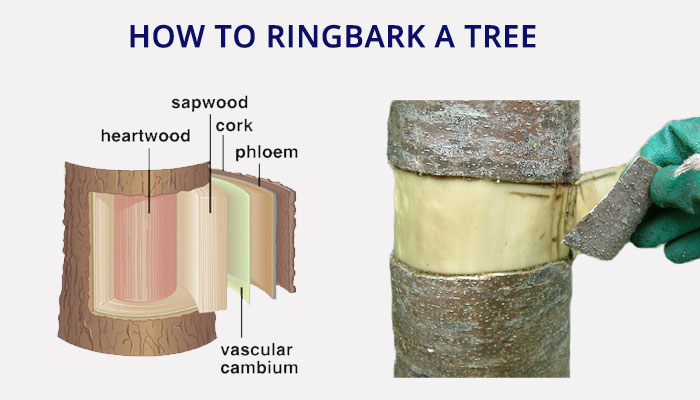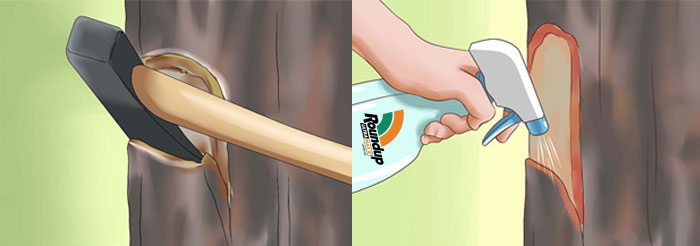Killing trees can be tough depending on the species. Invasive species like camphor laurel1 and willows are tough as nails, so you might need more than one trick up your sleeve to get the job done.
The easiest way to kill a tree would be to chop it down, but it is not exactly inconspicuous. The three best methods in order are:
1. Ring-bark the tree (fast)
2. Poison with Roundup (fast)
3. Copper nails (slow kill)
We have elaborated on the different ways via which you can kill a tree so that you can take your pick.
Ring-bark
Roundup
Copper nail
Ring-bark
Ring-bark a tree to kill it
This is probably the best method to kill a tree, but also the most obvious one. It entails making a cut all the way around the bark of the tree so it can no longer feed itself. It will be evident to anyone who sees the tree is has been killed on purpose.

You need to make sure you cut deep enough into the tree to remove the phloem and vascular cambium. These are the veins of the tree that send water to the leaves from the roots and return energy generated from photosynthesis back to the roots.
Once you cut off this supply the tree will die.
Roundup
Poison with Roundup
Roundup is the most common weed killer on the market, but it can also be used to kill trees.
- You will need to expose the bark by hacking into it with an ax or using a saw or drill.
- Then apply a 2:1 mix of water to roundup.
This will take 1 – 3 weeks to kill the tree and may take several applications for larger trees or invasive species.

Copper nail
Copper nails will kill a tree slowly
Copper nails can be used to kill trees without it being overly obvious that anything has been done to the tree. Copper nails must be hammered at the base of the tree penetrating past the bark into the phloem. There is no specific recommended size when it comes to choosing the perfect copper nail for the job, but a bigger nail usually inflicts more damage quickly as they have a larger surface area.
The longer a nail is, the deeper it will penetrate the tree. As a result, there will be a higher chance of killing it. According to Riley Morgan from Fortitude Tree Services, if you want quick results, you can hammer multiple nails around the tree, forming a ring. This will lead to a higher concentration of copper. If you want to use just one copper nail, then you will have to try it for very small trees. Larger trees can easily tolerate the effects of one nail.
What we cover
ToggleTry this FREE service
The fastest and easiest way to get 3 Estimates from the most affordable tree services near you would be by using this FREE service.
GoTreeQuotes helps to match you with the three local tree doctors who have been voted #1 by previous users in your area.
- They will give you free advice and estimates on any work that may need to be done.
- Scroll up to the top of the page and enter your ZIP Code.
- Enter a few details about your tree job plus some contact information.
- Your tree details are forwarded on to the closest three tree services all voted best priced who will also price your tree job.

Why not get it removed directly?
Even in cities with the strictest rules regarding tree removal, there are always ways around them.
Your tree dying is a great excuse to have it removed, but if you get caught it can also cost you a $10,000 fine.
My arborist says it’s a dangerous tree!
There are lots of things an arborist (tree care specialist) can see that you can’t, which might warrant your tree being removed without a permit.
Get a local arborist out to give you a free tree inspection and a price for removal.
They will soon tell you if you even need a permit or if you are okay to remove it without one.
Can you kill a tree with salt?
You can use Epsom salt to kill a tree discreetly much like the use of a copper nail. The method is surprisingly effective as you will discover when you try it out. This is because sodium which is present in salt hinders the flow of potassium and magnesium within the tree.
The tree needs both these elements making chlorophyll. The stunted supply of potassium and magnesium will lead to the absence of chlorophyll, and the tree will eventually die. The simplest way to go about is to sprinkle a ring of salt around the tree.
However, you need to know that just sprinkling salt in the general area will make it impossible to plant anything else in that area after the tree is dead due to the high salt concentration.
To avoid toxic soil follow these 3 steps:
- Drill some holes diagonally down into the tree. You should start the drilling at least five inches above the base of the tree. All the holes should be a minimum of three inches deep.
- Create a mixture of 3 cups of water and 6 cups of salt. You can experiment with it, but basically, you need a liquid with very high amounts of salt.
- You can then pour this solution down the drilled holes. Re-apply every few days and should take a few days to a few weeks for larger trees to take effect.
What is the quickest way to kill a tree?
While there are many ways you can kill a tree, some are faster than others. Some of the quickest ways to kill a tree are:
- Cut the tree down
- Use Roundup
- Use Epsom salt
- Ring-bark the tree
Is it illegal to kill trees?
This will depend on a number of factors. Every city and or state has its own set of laws when it comes to trees. Normally anything that is legal to remove is legal to kill (as they are basically the same thing).
You will need to check the tree removal Ordinance as it applies to your local city. Normally though if it’s a small tree or an invasive species, it is not illegal. If it is a larger specimen, then you will need to get a permit from your city first before you kill the tree.
Will the tree become dangerous once it is dead?
Dead trees are structurally unsound because their limbs are susceptible to breakage. They can fall on your property and cause damage, or injure someone. The longer a dead tree is left standing the more dangerous it becomes.
The only thing anchoring a tree to the ground is its roots. When a tree dies, those roots begin to rot. Once they have completely rotten through, the tree will eventually fall over. Once your tree is dealt with, you are best getting a professional tree surgeon in ASAP to remove the tree.
How do you kill a tree without anyone knowing?
If you want to kill a tree undetected, the best way to go about it would be to kill the tree slowly so that it does not die a sudden, suspicious death. You can drill some holes around the tree and pour Roundup in with a very weak mix ratio, maybe double the ratio recommended on the pack.
Apply it once per week and slowly build up the toxicity level ratio, slowly rising in the tree over a couple of months.
When you see the tree start to turn and die, laying off the poisoning to the death is slow. That way, your neighbors will be none the wiser.
- University of Florida IFAS Extension,(2024) Camphor Tree (Cinnamomum camphora) <https://plant-directory.ifas.ufl.edu/plant-directory/cinnamomum-camphora/> Accessed: 08-02-2024




